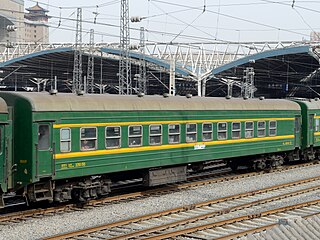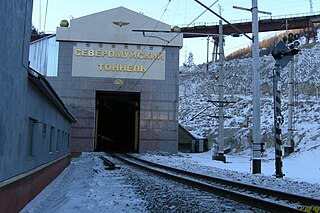
The Trans-Siberian Railway, historically known as the Great Siberian Route and often shortened to Transsib, is a large railway system that connects European Russia to the Russian Far East. Spanning a length of over 9,289 kilometers, it is the longest railway line in the world. It runs from the city of Moscow in the west to the city of Vladivostok in the east.

The Baikal–Amur Mainline is a 1,520 mm broad-gauge railway line in Russia. Traversing Eastern Siberia and the Russian Far East, the 4,324 km (2,687 mi)-long BAM runs about 610 to 770 km north of and parallel to the Trans-Siberian Railway.

A railroad car, railcar, railway wagon, railway carriage, railway truck, railwagon, railcarriage or railtruck, also called a train car, train wagon, train carriage or train truck, is a vehicle used for the carrying of cargo or passengers on a rail transport network. Such cars, when coupled together and hauled by one or more locomotives, form a train. Alternatively, some passenger cars are self-propelled in which case they may be either single railcars or make up multiple units.

VR-Group Plc, commonly known as VR, is a government-owned railway company in Finland. VR's most important function is the operation of Finland's passenger rail services with 250 long-distance and 800 commuter rail services every day. With 7,500 employees and net sales of €1,251 million in 2017, VR is one of the most significant operators in the Finnish public transport market area.

The Patria Pasi is a Finnish-made six-wheeled armoured personnel carrier (APC) originally designed for Finnish Defence Forces. The first variant was produced in 1983 and serial production began in 1984. It was designed to operate with ease of use, simple structure and low-cost maintenance. The basic appearance and configuration of the Pasi is similar to most other wheeled APCs. The XA-180 and XA-185 are fully amphibious while other variants are not.

An armoured train or armored train is a railway train protected with heavy metal plating and which often includes railway wagons armed with artillery, machine guns, and autocannons. Some have also had ports used to fire small arms from the inside of the train, especially in earlier armoured trains. For the most part, they were used during the late 19th and early 20th centuries, when they offered an innovative way to quickly move large amounts of firepower into a new location. Most countries have discontinued their use – road vehicles became much more powerful and offered more flexibility, train tracks proved too vulnerable to sabotage and attacks from the air, and air transportation was an even more flexible way to relocate firepower to a new location. However, there have been occasional uses in the late 20th century and early 21st century. The Russian Federation has used improvised armoured trains in the Second Chechen War (1999–2009) and in its invasion of Ukraine (2022–present).

Stepan Osipovich Makarov was a Russian vice-admiral, commander in the Imperial Russian Navy, oceanographer, member of the Russian Academy of Sciences, and author of several books. He was a pioneer of insubmersibility theory, and developer of a Cyrillic-based semaphore alphabet. A proponent of icebreaker use, he supervised the first ever polar icebreaker construction. Makarov also designed several ships.

LeShuttle is a railway shuttle service between Calais in France and Folkestone in United Kingdom. It conveys road vehicles and passengers by rail through the Channel Tunnel. Freight vehicles are carried in separate shuttle trains hauled by the same locomotives, that also contain a passenger carriage, known as the Club Car.

Ukrainian Railways or Ukrzaliznytsia (UZ) (Ukrainian: Укрзалізниця) is a state-owned joint-stock company administering railway infrastructure and rail transport in Ukraine; a monopoly that controls the vast majority of the railroad transportation in the country. Ukrainian Railways is the world's sixth largest rail passenger transporter and world's seventh largest freight transporter. As of 2020, the total length of the main broad-gauge (1,520 mm) railroad network was 19,787 kilometres (12,295 mi), making it the 13th largest in the world. Ukraine also has many stretches of standard-gauge railway (1,435 mm), and is currently working to expand these in order to improve its connections to the European Union.

Russian Railways is a Russian fully state-owned vertically integrated railway company, both managing infrastructure and operating freight and passenger train services.

Rail transport in Russia runs on one of the biggest railway networks in the world. Russian railways are the third longest by length and third by volume of freight hauled, after the railways of the United States and China. In overall density of operations /length of track, Russia is second only to China. Rail transport in Russia has been described as one of the economic wonders of the 19th, 20th, and 21st centuries.

Rail transport in Ukraine is a major mode of transport in Ukraine. Most railway infrastructure in Ukraine is owned by the government of Ukraine through Ukrzaliznytsia, a joint-stock company which has a de facto country-wide monopoly on passenger and freight transport by rail.

The Severomuysky Tunnel is a railroad tunnel on the Baikal Amur Mainline (BAM), in northwestern Buryatia, Russia. It is named after the Northern Muya Range it cuts through. The tunnel is 15.34 kilometres (9.53 mi) long, the longest in Russia.

Russia was and is the largest country in the world. Its geography of north–south rivers and east–west commerce, plus, importantly, the mostly flat terrain, made it very suited to develop railroads as the basic mode of transportation.
The Russian armoured train Yenisei is an armoured train currently in use by Russia in their ongoing invasion of Ukraine in 2022. According to Ukrainian sources, Yenisei was constructed out of parts stolen from Ukrainian Railways in the Kharkiv region.

Pro-democratic and pro-Ukrainian partisan movements have emerged in Belarus and Russia following the Russian invasion of Ukraine, a major escalation of the Russo-Ukrainian War. These resistance movements act against the authoritarian governments of Alexander Lukashenko in Belarus and Vladimir Putin in Russia, as well as against civilian supporters of these authorities and the armed forces of both countries, with the aim of stopping the war.
The rail war began in different regions of Russia in the spring of 2022 after a similar rail war in Belarus.
The Russian armoured train Volga is an armoured train currently in use by Russia in its ongoing invasion of Ukraine in 2022. Unlike its sister train Yenisei, which is built primarily for logistics and refugee ferrying, Volga is primarily used for engineering, reconnaissance, mine clearance, restoration of damaged railway tracks, and escorting cargo within the Ukrainian combat zones.
The Russian armoured train Baikal is an armoured train currently in use by Russia in its ongoing invasion of Ukraine in 2022. Unlike the newer trains Yenisei and Volga, Baikal was already built long before the Russian invasion of Ukraine. Both Baikal and its sister train, Amur were reactivated back in 2016, originally for rear-line logistical purposes.














